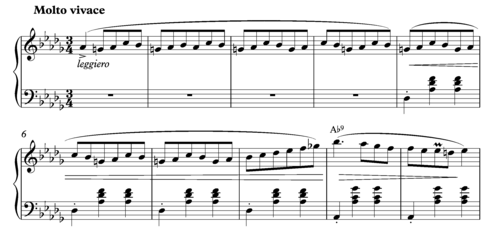Minute Waltz
The Waltz in D-flat major, Op. 64, No. 1, Valse du petit chien (French for "Waltz of the puppy"), popularly known in English as the "Minute Waltz", is a piano waltz composed by Frédéric Chopin. It is dedicated to the Countess Delfina Potocka.


History
Chopin composed the waltz in 1847 and had it published by Breitkopf & Härtel[1] in Leipzig the same year, as the first of the Trois Valses, Op. 64. The second waltz is in the enharmonic parallel minor key of C-sharp minor.
Structure
The waltz is in the key of D-flat major and has a tempo marking of molto vivace (very lively). Chopin indicates that the waltz is to be played with the sustain pedal used, and makes frequent use of crescendos and diminuendos. It is in a simple ternary form, as are many of Chopin's compositions. The A section is marked leggero, and the B section sostenuto. The A section itself can be divided into two themes, separated by a double bar. The first consists of the familiar opening melody over standard waltz accompaniment, frequently rising an octave only to drop back down. The second theme is similar, but not identical, and features several broken scales over several octaves between a repeated quarter note and triplet motive. The B section is somewhat calmer, using alternating half and quarter notes over waltz accompaniment. Following a lengthy trill, the A section is then repeated, modified only in the ending, which now features a three octave descent instead of a two octave one.
Tempo
The piece is given the tempo marking Molto vivace. Although it has long been known as the "Minute" Waltz, its nickname was intended to mean "small" in the sense of a "miniature" waltz, given by its publisher.[2] Chopin did not intend for this waltz to be played in one minute. A typical performance of the work will last between 1 1⁄2 and 2 1⁄2 minutes.[3] The waltz is 140 measures long with one fifteen-measure repeat included, and thus it would have to be played at almost 420 quarter notes per minute in order to play it completely within a single minute. Playing the piece as fast as possible is still a feat some pianists attempt.[4] Camille Bourniquel, one of Chopin's biographers, reminds the reader that Chopin got the inspiration for this waltz as he was watching a small dog chase its tail, which prompted the composer to name the piece Valse du petit chien, meaning "The Little Dog Waltz".[5][6]
Derivative works
A vocal version of the piece, with lyrics by screenwriter Lan O'Kun, has been performed by multiple artists, including Barbra Streisand on her 1966 album Color Me Barbra, her version peaked at #23 in the Billboard's Easy Listening chart.[7] O'Kun's lyrics perpetuate the notion that the tune should be performed in one minute, although Streisand's performance clocks in at just under two minutes. This version was also performed by a female Muppet on the 1969–70 premiere season of Sesame Street.[8]
New Orleans rhythm and blues pianist James Booker included an instrumental version on his album Junco Partner (1976).[9]
References
- Letter of Frédéric Chopin to Breitkopf & Härtel (Paris, 30 June 1847), in Selected Correspondence of Fryderyk Chopin, translated and edited by Arthur Hedley, McGraw-Hill Book Company, inc., New York, Toronto, London, 1963, Library of Congress Catalog Card Number:62-17703 27815.
- Maurice Hinson (June 2004). The Pianist's Dictionary. Indiana University Press. p. 114. ISBN 978-0-253-21682-3.
This piece bears an erroneous nickname since the story long associated with this nickname presumes the pianist is supposed to play the piece in one minute. The word "minute" means small or little waltz.
- Frédéric Chopin; Joseph Banowetz (2000). Piano works. Alfred Music Publishing. p. 6. ISBN 978-0-7692-9854-2.
- Setting the metronome at 200 bpm, for a total of nearly 420 quarter notes, gives a few seconds over two minutes playing time.
- Frédéric Chopin; John W. Schaum (2001). Chopin-Schaum, Bk 1: Based on Events and Episodes of Chopin's Life. Alfred Music Publishing. p. 8. ISBN 978-0-7579-0511-7.
Sometimes called Minute Waltz Chopin's puppy cuddled quietly at ... This was the happy memory that helped Chopin write the waltz "Little Dog Chasing His Tail".
- George Sand's little dog, "Marquis", was the dog of the Valse du petit chien. It had befriended Chopin who mentions it in several of his letters, one from Nohant, dated 11 October 1846, another from Paris, dated 25 November 1846, in which he writes to George Sand: "Please thank Marquis for missing me and for sniffing at my door." in Selected Correspondence of Fryderyk Chopin, collected and annotated by Bronislaw Edward Sydow, translated and edited by Arthur Hedley, McGraw-Hill, New York, Toronto, London, 1963, pp. 267 & 272.
- Nielsen Business Media, Inc. (11 June 1966). Billboard Top 40 – Easy Listening. Nielsen Business Media, Inc. pp. 20–. ISSN 0006-2510.
- Sesame Street Minute Waltz, https://www.youtube.com/watch?v=XZrvI4Ie2Dw
- "Junco Partner – James Booker | Songs, Reviews, Credits". AllMusic. Retrieved 11 March 2019.
External links
- Minute Waltz: Scores at the International Music Score Library Project (IMSLP)
- Free sheet music of the Minute Waltz from Cantorion.org
- Quatre Mains version for piano duet
- Free recording of the Minute Waltz